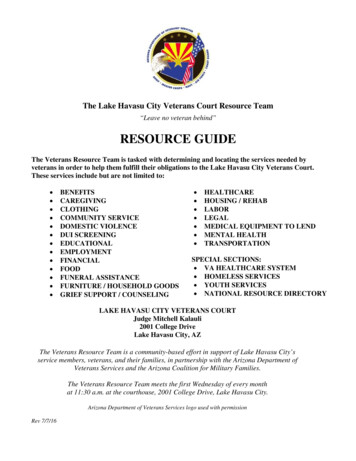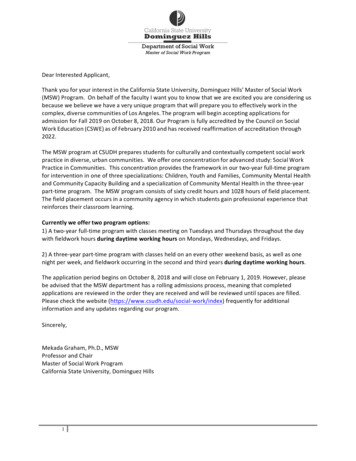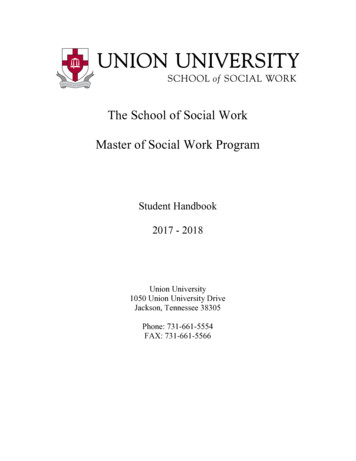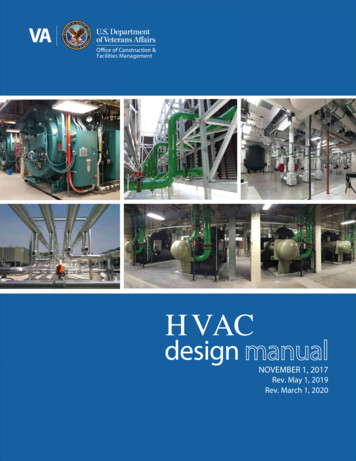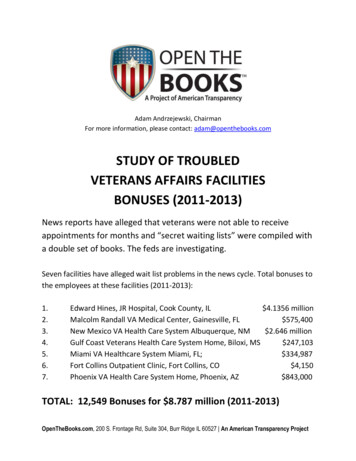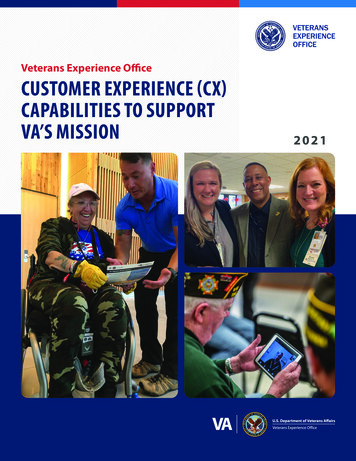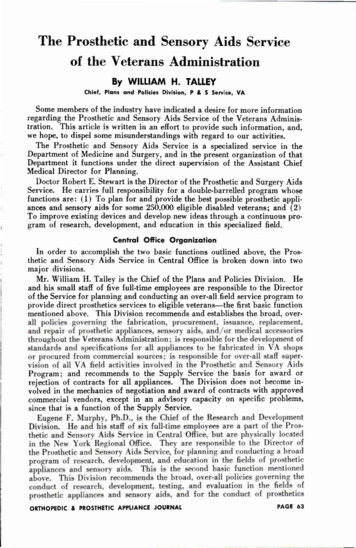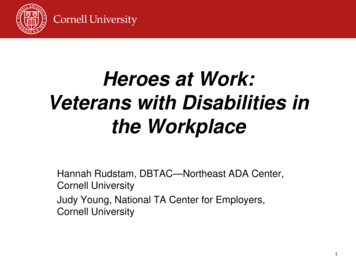
Transcription
Heroes at Work:Veterans with Disabilities inthe WorkplaceHannah Rudstam, DBTAC—Northeast ADA Center,Cornell UniversityJudy Young, National TA Center for Employers,Cornell University1
A resource The Disability &Business TechnicalAssistance Center1 800 949 4232Offering training, consulting, andtechnical assistance2
Toll free phone line: 866-327-6669Email: earn@earnworks.comWebsite: www.earnworks.comConsultation, training, and TA nationally on: recruitment resources website accessibility disability etiquette job retention ADAAA, Section 503 and VEVRAA855-AskEARN; earn@earnworks.comwww.earnworks.com3
In a nutshell, let’s consider 1. Overview: Rates & types of disabilities experienced by veterans2. Overview: Laws that apply to veterans in the workplace3. Employers’ attitudes toward employing vets and vets withdisabilities4. The unique nature of the “signature” disabilities of TBI and PTSD5. Workplace implications: special dynamics of signature disabilities6. Resources available to employers7. Strategies/best practices for employers to be effective8. What still needs to be done for employer resources?9. Your questions4
1Overview:Rates & types ofdisabilitiesexperienced byveterans
Overview: Disability rates & typesDOD rates across OIF, OEF & OND*Total casualties:41,675Largest reason code:WEAPONRY, EXPLOSIVE DEVICE29,789*US Department of Defense (DoD) Personnel and ProcurementStatistics astop.htm .
By the numbers* There are 23.2 million veterans in theU.S. as of 2008 5.5 million have some level of adiagnosed disability 10.4 million veterans are in theworkforce as of 2008*US Census Bureau . Veteran Facts and Statistics, Oct., veteranstatistics.phpAt
By the numbers* Obvious disabilities:Limb injuriesBurn injuriesSpinal cord injuriesSome traumatic brain injuriesNon-obvious disabilities:Post-traumatic stress disorderSome traumatic brain injuries
Returning veterans Arguably, the number of veterans with nonobvious disabilities far exceeds those withobvious disabilitiesThe two signature disabilities for Iraq andAfghanistan veterans are:1. Post-traumatic stress disorder(PTSD)2. Traumatic brain injury (TBI)
Consider these statistics Rate of fully blown PTSD among Iraq andAfghanistan vets was 6% diagnosed with anadditional 27% probable, but undiagnosed*Rate of TBI among Iraq and Afghanistan vetsranges from about 20 – 30%***Erbes, C., Westermeyer, J., Engdahl, B. & Johnsen, E. (2007). Posttraumatic stress disorder and service utilization in a sample of servicemembers from Iraq and Afghanistan. Military Medicine, 172, 359-363.**Approximately 20% of all combat-related military casualties have sustained abrain injury (ARNEWS (Army News Service), Spc. Chuck Wagner, Nov.24, 2003, "Brain Injuries High Among Iraq Casualties").**Nearly 30% of all combat-related injuries seen at Walter Reed Army MedicalCenter from 2003 to 2005 included brain injury. (Defense and VeteransBrain Injury Center)
2Overview:Legal and policyissues aroundveterans in theworkplace
Overview: Legal and policy issuesMain laws covering veterans withdisabilities in the workforce The Uniformed ServicesEmployment and ReemploymentRights Act (USERRA) Some state-specific laws FMLA—New provisions Title I of the ADA
Overview: Legal and policy issuesA 27 year old returns from Iraq with PTSD. Amiddle school teacher prior to his service inIraq, he now plans on limiting his job search tonon-skilled work because he is sure he willnever be hired for professional jobs when hetells his potential employer about his disability.A 24 year old soldier is recovering from a traumaticbrain injury. She plans on hiding her disabilityfrom her employer because she fears she willbe terminated if her employer finds out.A 32 year old returns from Iraq with a spinal cordinjury. An IT professional prior to his service, hebelieves he will not be able to return to his oldjob because the building he worked in lacks anelevator.
Overview: Legal and policy issuesAbout Title I of the ADA and veterans Clear need to build awareness ofADA employment rights– Veterans with disabilities themselves– Employers No special ADA employment rightsfor veterans Enforced by the EEOC
Overview: Legal and policy issuesAbout Title I of the ADA and veterans Right to non-discrimination! Right to have disclosure as achoice Right to accommodation Right to equal benefits Right to an accessible workplace Other
3Employers’attitudes towardhiring veteranswith disabilities
SHRM Poll:3Employing MilitaryPersonnel &RecruitingVeterans—Attitudes& PracticesJune 2010
3Highlights:43% of employers pay nocompensation; 3% pay fullcompensationWhat employers have in place fortransition back to work:66% - EAP58% - Training for re-skilling48% - Flexible work arrangements44% - Recognition by management53% had hired a vet (incl temporaryworkers)
3Highlights:Did employers make a special effort to recruitvets?50% of those who had hired11% of those who had not hiredWhat do employers feel are challenges inhiring vets? Top 5 challenges:Transitioning skills from military: 60%Transitioning culture: 485PTSD & combat-related mental health: 46%Adapting to civilian worklife: 36%Combat-related disabilities: 22%
3About our upcomingresearchA collaboration with SHRMNationalSurvey of 1000 HRprofessionals on issuesspecific to employingveterans with disabilities
4The unique natureof the “signature”disabilities of TBIand PTSD
The special dynamic of these“signature” veterans’ disabilities Under-diagnosed—Inadequate screeningmechanisms Under-reported Many will not be fully diagnosed & treateduntil long after return to civilian life Change a lot over time Can have a wide range of symptoms andsubtle manifestations Tend to be highly stigmatized
About PTSD Three major categories of diagnostic criteria*1. Re-experiencing Symptoms––Uncontrollable flashbacksNightmares2. Avoidance Symptoms––Withdrawing from othersLoss of interest in life activities3. Hyper-arousal–––Sleep problemsUnexplained angerDifficulty concentratingSymptoms can “creep up” –not necessarily presentimmediately after the event*4th edition of the Diagnostic and Statistical Manual of Mental Disorders(or DSM-IV).
About TBI A leading cause is blast injuries, ranging from lifethreatening to mild/undetectedOur screening systems for TBI are probablyinadequateA very complex injury, with subtle symptoms:–––––––––––Sleep problemsImpaired memoryPoor ty/mood changesHeadache/dizzinessFatigueNoise/light intoleranceRinging in the ears (tinnitus)Vision change: blurred or vision
5What does thismean foremployers?Workplaceimplications
And what does this mean toemployers?Many soldiers may still be in the process of admittingand adjusting to their disability long after they havereturned to civilian work lifeTheir conditions & treatment plans may still be in theprocess of adjustment well into their civilian worklivesNo “one size fits all.” Course of recovery andemployment needs is different for each individual
Symptoms and accommodation optionsfor PTSD and TBI often overlap:Memory problems: Written instructions; task remindersElectronic organizers; calendarsSystematic check-ins/tracking systemsConcentration problems: Break down tasks of large assignmentsWork environment/privacyHeadphonesWhite noiseCoping with Stress: Schedule modificationsAllow for walks or other relaxing activity during breakProvide more time to learn new responsibilitiesAllow time off for therapyWork with a compatible mentor
Symptoms and accommodation optionsfor PTSD and TBI often overlap:Interacting with co-workers or supervisor: Alternative communication systemsWork at home option (can be part time)Clarity expectations and give positive coaching/feedbackAssign feedback partnerSleep disturbances: Provide consistent scheduleCombine short breaks into a long break for a napFine motor skills issues: Alternative input devices for computerSpeech to text softwareErgonomic phones, desks and office equipmentLarge motor skills issues: Universal design Basics of accessibility
And, finally, some “don’ts” foremployers:Don’tTry to diagnose conditions or speculate about adisability issueAssume that all employees with PTSD or TBI arealike—each case is different(As with anyone else) Excuse or ignoreperformance issues until they become too bigto manageAssume they are “faking it”Assume that once an accommodation is in place,nothing more needs to happen—theseconditions change significantly over time
And, finally, some overall bestpractices for employers:Do:Spread the word to mid-levelmanagers/supervisorsCoach—as you would anyone elseHave resources and options readyHave an EAP program for everyoneConsider an affinity/resource groupUse accommodations that, as much as possible,keep veteran engaged in the jobBe flexible and creative with accommodationapproaches
A final note It takes more than good will to welcomeand support veterans in their return tothe workforceDeveloping an organizational culture and climatearound inclusion, diversity and disabilityinclusiveness is the keyAsk yourself: What happens to employees in myworkplace when they come forward with theirdisability and ask for an accommodation?Ultimately, this is what will happen to veterans
Resources for Recruiting,Hiring, Accommodating,and Retaining Veteranswith Disabilities32
www.AmericasHeroesAtWork.gov
olkit/34
VetSuccess.gov35
FedsHireVets.gov36
RealWarriors.net37
www.Hireheroesusa.org38
Wounded Warrior ProgramsEach military branch has its own programand manager to help employers recruit Army Wounded Warrior Program Air Force Wounded Warrior Program Marines for Life and Navy Safe HarborMilitary installations have transition centersthat assist with employment of veterans39
Additional Recruitment Resources forVeterans and Veterans with Disabilities One- Stop Centers:http://www.servicelocator.orgDisabled Veteran Outreach Program Specialist Department of Veteran Affairs regional offices of Vocational Rehabilitation &Employment: www.vba.va.gov o/40
Dispelling the Myths –Online Training to: Educate HR professionals, managers and othersabout TBI and PTSD related employment issues Illustrate the helpful role that employment canplay in the recovery of wounded warriors Present basic information about TBI and PTSD Offer scenario-based learning Provide links to tools and resources to helpensure a successful employment environment– ns/41
Veterans with Disabilities and the ADA:A Guide for Employers Describes differences betweenUSERRA and ADA for veterans withdisabilities Provides information on how the ADAapplies to recruiting, hiring andaccommodating veterans with serviceconnected abilities-employers42
Job Accommodation Network (JAN)http://askjan.org43
Strategies and Best Practices Develop a strategy for veterans hiring Build relationships with veteran serviceorganizations and military bases Train recruiters to recognize theapplicability of military skills for civilianpositions Utilize the Skills Translator on O*NEThttp://online.onetcenter.org/ Attend veteran-specific job fairs44
Strategies and Best Practices Provide training for managers and HR onveteran employment issues Develop a mentoring program for veterans Provide information on availability of EAP Communicate regularly to assessemployees’ success in transitioning Establish veteran specific EmployeeResource Group45
Selected Best Practices Veterans’ affairs office focusing onrecruiting, hiring and support servicesCSX Transportation veterans’ affairs committee of managers andexecutives who served in the militaryVerizon Communications Inc. Coaching transitioning vets on resumes,interviewing, and job search techniquesCACI International, Inc.46
Selected Best Practices Maintain a vet-centric web portal– Raytheon Find mentors already inside the company Use them in the interviewing andonboarding process– Sears Holdings Corp.47
Dec 17, 2010 · CACI International, Inc. 46. Selected Best Practices Maintain a vet-centric web portal – Raytheon Find mentors already inside the company Use them in the interviewing and onboarding process – Sears Holdings Corp. 47. Title: PowerPoint Presentation Author: Martha Fitzgerald
